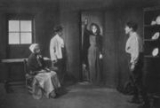
Cathleen Ní Houlihan
Encyclopedia
Cathleen Ní Houlihan is a one-act play written by Irish
playwright
William Butler Yeats
in collaboration with Lady Gregory
in 1902 and first performed on 2 April of that year. The play is startlingly nationalistic
, encouraging in its last pages that young men sacrifice their lives for the heroine Cathleen Ní Houlihan
, who represents an independent and separate Irish state. The title character first appears as an old woman, at the door of a family celebrating their son's wedding. She describes her four "beautiful green fields," representing the four provinces
, that have been unjustly taken from her. With little subtlety, she requests a blood sacrifice
, declaring that "many a child will be born and there will be no father at the christening
". When the youth agrees and leaves the safety of his home to fight for her, she appears as an image of youth with "the walk of a queen," professing that of those who fight for her: "They shall be remembered forever, They shall be alive forever, They shall be speaking forever, The people shall hear them forever." This call to immortality through martyrdom is not unique to the Irish struggle for independence
.
Irish people
The Irish people are an ethnic group who originate in Ireland, an island in northwestern Europe. Ireland has been populated for around 9,000 years , with the Irish people's earliest ancestors recorded having legends of being descended from groups such as the Nemedians, Fomorians, Fir Bolg, Tuatha...
playwright
Playwright
A playwright, also called a dramatist, is a person who writes plays.The term is not a variant spelling of "playwrite", but something quite distinct: the word wright is an archaic English term for a craftsman or builder...
William Butler Yeats
William Butler Yeats
William Butler Yeats was an Irish poet and playwright, and one of the foremost figures of 20th century literature. A pillar of both the Irish and British literary establishments, in his later years he served as an Irish Senator for two terms...
in collaboration with Lady Gregory
Augusta, Lady Gregory
Isabella Augusta, Lady Gregory , born Isabella Augusta Persse, was an Irish dramatist and folklorist. With William Butler Yeats and Edward Martyn, she co-founded the Irish Literary Theatre and the Abbey Theatre, and wrote numerous short works for both companies. Lady Gregory produced a number of...
in 1902 and first performed on 2 April of that year. The play is startlingly nationalistic
Irish nationalism
Irish nationalism manifests itself in political and social movements and in sentiment inspired by a love for Irish culture, language and history, and as a sense of pride in Ireland and in the Irish people...
, encouraging in its last pages that young men sacrifice their lives for the heroine Cathleen Ní Houlihan
Kathleen Ni Houlihan
Kathleen Ni Houlihan is a mythical symbol and emblem of Irish nationalism found in literature and art, sometimes representing Ireland as a personified woman. The figure of Kathleen Ni Houlihan has also been invoked in nationalist Irish politics...
, who represents an independent and separate Irish state. The title character first appears as an old woman, at the door of a family celebrating their son's wedding. She describes her four "beautiful green fields," representing the four provinces
Provinces of Ireland
Ireland has historically been divided into four provinces: Leinster, Ulster, Munster and Connacht. The Irish word for this territorial division, cúige, literally meaning "fifth part", indicates that there were once five; the fifth province, Meath, was incorporated into Leinster, with parts going to...
, that have been unjustly taken from her. With little subtlety, she requests a blood sacrifice
Martyr
A martyr is somebody who suffers persecution and death for refusing to renounce, or accept, a belief or cause, usually religious.-Meaning:...
, declaring that "many a child will be born and there will be no father at the christening
Infant baptism
Infant baptism is the practice of baptising infants or young children. In theological discussions, the practice is sometimes referred to as paedobaptism or pedobaptism from the Greek pais meaning "child." The practice is sometimes contrasted with what is called "believer's baptism", or...
". When the youth agrees and leaves the safety of his home to fight for her, she appears as an image of youth with "the walk of a queen," professing that of those who fight for her: "They shall be remembered forever, They shall be alive forever, They shall be speaking forever, The people shall hear them forever." This call to immortality through martyrdom is not unique to the Irish struggle for independence
Irish War of Independence
The Irish War of Independence , Anglo-Irish War, Black and Tan War, or Tan War was a guerrilla war mounted by the Irish Republican Army against the British government and its forces in Ireland. It began in January 1919, following the Irish Republic's declaration of independence. Both sides agreed...
.

